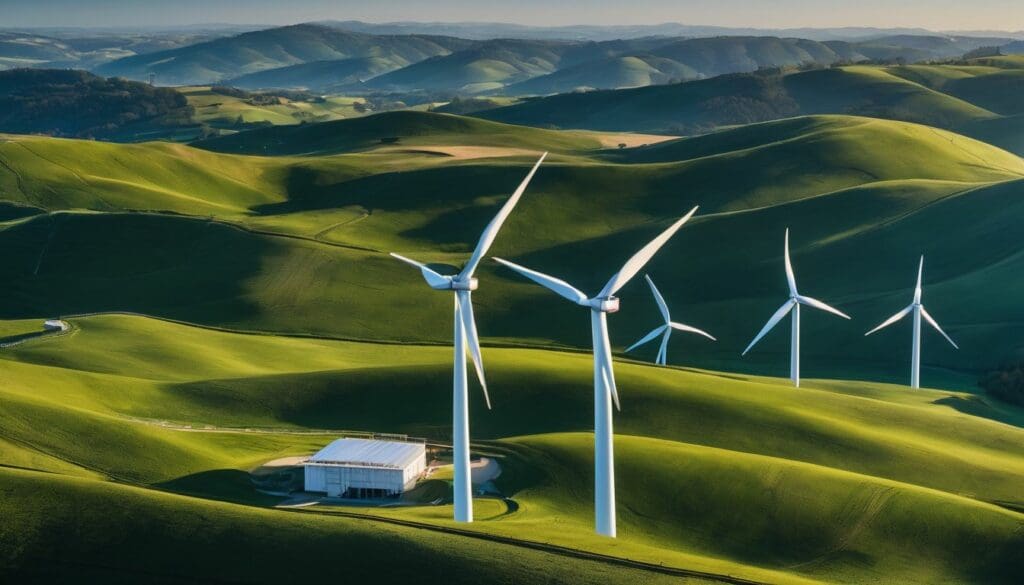Our planet is feeling the heat, with rising temperatures and extreme weather becoming more common. Renewable energy is key in combating this, as it currently prevents around 2 billion tonnes of carbon emissions each year.
This blog will guide you through how harnessing wind, sun, and water can significantly cut down the harmful gasses choking our atmosphere. Stay tuned – the future is bright and green!
Key Takeaways
- Renewable energy comes from natural, replenishing sources like the sun, wind, and water and contributes to significant reductions in harmful emissions.
- Switching to renewable energy not only cuts down on pollution but also offers economic benefits by creating jobs and reducing energy costs for consumers.
- Countries like Germany and China are leading the way in adopting renewable technologies, with Germany sourcing over 46% of its electricity from renewables as of 2019.
- Government policies, investments, incentives along with education and awareness are crucial for increasing the use of these clean energy sources.
- Collaborative innovation within the sector is key to advancing renewable technologies further and accelerating our shift towards a low-carbon economy.
What is Renewable Energy?
Renewable energy is energy that comes from naturally replenishing sources, such as sunlight, wind, and water. It provides an alternative to traditional fossil fuels and can help reduce emissions that contribute to air pollution and climate change.
Definition
Renewable energy comes from natural processes that are constantly replenished. This includes sunlight, wind, rain, tides, waves, and geothermal heat. These sources stand out because they produce little to no greenhouse gas emissions during energy generation.
As such, they play a critical role in combating climate change by providing environmentally friendly alternatives to fossil fuels.
Unlike conventional power sources that can deplete over time like coal and oil, renewable resources remain abundant and sustainable. They offer a way to generate electricity access without compromising the health of our planet or contributing significantly to air pollution.
By harnessing these clean energy forms, we move towards a low-carbon economy while protecting the environment for future generations.
Types of Renewable Energy Sources
Benefits of Renewable Energy
Renewable energy reduces emissions, is cheaper and healthier, creates job opportunities, and provides economic advantages. It plays a crucial role in protecting the environment and promoting sustainability.
Reducing Emissions
Renewable energy plays a crucial role in reducing emissions by significantly decreasing the amount of greenhouse gases released into the atmosphere. This environmentally-friendly energy source helps lower carbon footprints and promotes a low-carbon economy, contributing to environmental protection and future energy sustainability.
By harnessing renewable power, we can actively work towards creating a cleaner and healthier planet for generations to come.
Choosing renewable energy sources over traditional options is an impactful step towards environmental preservation and sustainable living. As we delve deeper into the benefits of renewable energy, it’s important to understand how this alternative energy form fosters positive change beyond emission reduction.
Cheaper and Healthier
Renewable energy is cheaper and healthier for both individuals and the environment. Transitioning to renewable energy sources reduces the cost of electricity, making it more affordable for consumers.
Additionally, it lowers healthcare expenses by decreasing air and water pollution, leading to improved public health. Embracing renewable energy technologies also creates employment opportunities in sustainable industries while promoting a cleaner and greener future.
The shift towards renewable energy offers financial savings for households and businesses while fostering better health outcomes and a more sustainable environment. This transition not only benefits the economy but also contributes to reducing emissions, paving the way for a healthier planet.
Job Creation
Renewable energy initiatives create new job opportunities in various sectors such as manufacturing, installation, and maintenance. The growth of renewable energy fosters employment through the need for skilled workers to build and manage solar panels, wind turbines, and other green technologies.
As demand for clean energy increases, so do opportunities for engineers, technicians, project managers, and research professionals.
Furthermore, the shift towards renewable energy drives economic development by supporting local businesses and encouraging entrepreneurship. This transition encourages innovation in sustainable solutions which results in additional jobs across the supply chain from suppliers to retailers.
Economic Advantages
Renewable energy offers significant economic advantages. It creates jobs in the manufacturing, installation, and maintenance of renewable energy systems. Additionally, producing and using renewable energy reduces reliance on imported fuels, leading to a more stable economy.
Furthermore, investing in renewables can lead to cost savings over time due to lower operating and maintenance expenses. In turn, this drives local economic growth by keeping more money within the community.
Moreover, the transition towards renewable energy sources provides opportunities for new industries and markets as well as technological innovation which stimulates economic growth.
Ways to Increase the Use of Renewable Energy
through government policies, investment and incentives, education and awareness, as well as collaboration and innovation. Read on to discover how these strategies can help increase the use of renewable energy for a more sustainable future.
Government Policies
Government policies play a pivotal role in promoting the use of renewable energy. By providing incentives and subsidies, governments can encourage businesses and individuals to invest in clean energy technologies such as solar, wind, and hydro power.
Additionally, setting ambitious targets for renewable energy generation and implementing regulations that limit carbon emissions from traditional energy sources can further drive the transition towards a low-carbon economy.
Furthermore, governments can support research and development initiatives that focus on improving the efficiency and affordability of renewable energy technologies. By fostering innovation in this sector, countries can accelerate the adoption of eco-friendly energy solutions while creating new opportunities for economic growth and job creation.
Investment and Incentives
Investing in renewable energy projects can yield significant returns both for the environment and the economy. Governments and private investors alike are providing incentives such as tax credits, grants, and subsidies to encourage the development and adoption of eco-friendly technologies.
These investments not only promote the growth of a low-carbon economy but also stimulate innovation in energy efficiency and environmentally friendly technologies.
By offering financial benefits to businesses and individuals who embrace green energy initiatives, governments aim to create a more sustainable future while simultaneously addressing climate change concerns.
Such investments contribute towards achieving carbon-neutral energy systems that are essential for reducing emissions on a global scale.
Moving forward, it’s crucial for leaders in government policy to continue championing these incentives whilst encouraging collaboration between public and private sectors – bolstered by further education and awareness campaigns on environmental sustainability within communities, industries, and institutions.
Education and Awareness
To effectively increase the use of renewable energy, educating and creating awareness among the public is crucial. By providing clear information about the benefits and availability of eco-friendly technologies, individuals can make informed decisions to support conservation efforts and environmental sustainability.
This education initiative will empower people to advocate for government policies that promote low-carbon economies, leading to a significant reduction in greenhouse gas emissions.
Fostering widespread awareness of renewable energy sources encourages communities to embrace environmentally friendly alternatives. Through education on carbon-neutral energy solutions, societies become empowered to actively participate in reducing emissions and transitioning towards a cleaner and healthier future.
Collaboration and Innovation
Transitioning from education and awareness to collaboration and innovation, it is evident that effective partnerships and creative solutions are essential for advancing renewable energy.
By working together, governments, businesses, and research institutions can develop new technologies and strategies for harnessing clean energy. Innovation plays a crucial role in improving the efficiency of renewable energy sources like solar, wind, and hydro power while reducing costs.
With collaborative efforts and innovative approaches, we can accelerate the transition to a low-carbon economy.
Leading Countries in Renewable Energy
The top 5 countries leading the way in renewable energy include Germany, China, United States, Japan and India. These countries have successfully implemented policies and investments to increase their use of renewable energy sources.
Top 5 Countries
Renewable energy advancements have positioned several countries at the forefront of the global transition towards clean power. Here is a glance at the top five countries leading in renewable energy adoption:
| Country | Renewable Energy Source | Notable Achievement |
|---|---|---|
| China | Hydropower, Solar, Wind | Largest producer of solar energy. |
| United States | Wind, Solar, Hydropower | Second-largest wind power producer. |
| Brazil | Hydropower, Biomass, Wind | Over 75% of electricity from renewables. |
| Germany | Wind, Solar, Biomass | Pioneer in solar PV technology. |
| India | Wind, Solar, Hydropower | Fourth-largest wind power capacity. |
Success Stories
Germany has successfully transitioned to renewable energy, with over 46% of its electricity coming from renewable sources in 2019. The country’s commitment to phasing out nuclear power and reducing carbon emissions has led to significant advancements in wind and solar energy technologies.
This shift has not only lowered greenhouse gas emissions but also created numerous jobs and positioned Germany as a global leader in sustainable energy.
China has made remarkable strides in renewable energy, becoming the world’s largest producer of solar panels and wind turbines. The country’s investment in clean energy infrastructure, backed by government policies and incentives, has propelled it towards a low-carbon economy.
Conclusion
In conclusion, renewable energy plays a crucial role in reducing emissions. It provides a cleaner, more sustainable alternative to traditional energy sources. By embracing renewable energy, we can work towards creating a healthier and greener future for the planet.
It’s essential for individuals and governments to continue investing in and supporting the development of renewable energy technologies. Making strides in this direction can lead us toward a more environmentally friendly and sustainable future.
FAQs
1. What exactly is renewable energy’s role in reducing emissions?
Renewable energy plays a key role in cutting down greenhouse gas emissions by providing low-carbon and non-polluting sources of power, helping to shift towards a carbon-neutral and eco-friendly economy.
2. Can using renewable energy sources lead to an environmentally friendly future?
Yes, employing renewable energy is essential for creating an environmentally-friendly future as it relies on clean technologies that emit little or no pollutants into the atmosphere.
3. Are eco-friendly technologies important for green energy?
Absolutely! Eco-friendly technologies are vital because they use resources like wind and solar power more efficiently, reducing our reliance on fossil fuels which contribute to greenhouse gas production.
4. How does adopting nonpolluting energy help achieve a low-carbon economy?
Adopting nonpolluting energy supports the transition to a low-carbon economy by slashing emission levels and paving the way for sustainable, carbon-neutral growth that doesn’t harm the environment.





